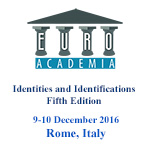Euroacademia Conferences
 Europe Inside-Out: Europe and Europeanness Exposed to Plural Observers (9th Edition) April 24 - 25, 2020
Europe Inside-Out: Europe and Europeanness Exposed to Plural Observers (9th Edition) April 24 - 25, 2020 Identities and Identifications: Politicized Uses of Collective Identities (9th Edition) June 12 - 13, 2020
Identities and Identifications: Politicized Uses of Collective Identities (9th Edition) June 12 - 13, 2020 8th Forum of Critical Studies: Asking Big Questions Again January 24 - 25, 2020
8th Forum of Critical Studies: Asking Big Questions Again January 24 - 25, 2020 Re-Inventing Eastern Europe (7th Edition) December 13 - 14, 2019
Re-Inventing Eastern Europe (7th Edition) December 13 - 14, 2019 The European Union and the Politicization of Europe (8th Edition) October 25 - 26, 2019
The European Union and the Politicization of Europe (8th Edition) October 25 - 26, 2019 Identities and Identifications: Politicized Uses of Collective Identities (8th Edition) June 28 - 29, 2019
Identities and Identifications: Politicized Uses of Collective Identities (8th Edition) June 28 - 29, 2019 The European Union and the Politicization of Europe (7th Edition) January 25 - 26, 2019
The European Union and the Politicization of Europe (7th Edition) January 25 - 26, 2019 7th Forum of Critical Studies: Asking Big Questions Again November 23 - 24, 2018
7th Forum of Critical Studies: Asking Big Questions Again November 23 - 24, 2018 Europe Inside-Out: Europe and Europeanness Exposed to Plural Observers (8th Edition) September 28 - 30, 2018
Europe Inside-Out: Europe and Europeanness Exposed to Plural Observers (8th Edition) September 28 - 30, 2018 Identities and Identifications: Politicized Uses of Collective Identities (7th Edition) June 14 - 15, 2018
Identities and Identifications: Politicized Uses of Collective Identities (7th Edition) June 14 - 15, 2018
Identities on the Walls
-
-

-
Presentation speakers
- Fredrika Larsson, Lund University, Sweden
- Download presentation
Abstract
An identity, or a group identity, can be argued to contribute both to unity and discord by default. Collective identities are always formed in boundary setting practices in the meeting of the Other, Barth has argued. However, when discussing identities as contributing to discord it is vital to distinguish identities in peace and identities in conflict. In addition to this, we must also discuss the nexus of identities, narratives and conflict. Collective identities are always based in a historical narrative, which are always formed in correspondence to the present thereby making sense of the present through the past. Through said historical narrative individuals can place his or her own experiences and thereby give meaning and cohesion to said experiences. If there is a conflict the narrative is formed to legitimise the conflict through the past and present the conflict as an ancient battle of the two communities. The distinction between an identity in a conflict and an identity in peace also lies in whether the narrative is open or closed. A collective identity in peace has an open narrative, thus containing several meanings and narratives thereby enabling different forms of membership of the collective identity. An identity in conflict is a closed identity i.e. the identity contains one historical narrative, one meaning, subsequently meaning one form of membership. The historical narrative has also been internalised into the group identity making it more important but also transforming the past into a hurtful place. Furthermore, this leads to a distorted temporality in which time is circular rather than linear. However, in order to discuss said nexus we must discuss what mechanisms and variables that close these identities. Johan Galtung has argued that cultural violence legitimises all other forms of violence by making violence feel right, justified and necessary. Historical narratives are used to legitimise the conflicts and due to its close affinity to identities we can see a plausible explanation to what closes identities in conflicts. Cultural violence is manifested in cultural forms such as art, language and other cultural expressions. The argument of the proposed paper is that cultural violence lies in historical narratives, by forming identities in opposition to each other, thereby legitimising the conflict in question. In order to investigate cultural violence we must find a cultural expression that presents a historical narrative that legitimises, justifies and celebrates violence. In Northern Ireland there is a tradition of painting large murals on the walls of Belfast and (London)Derry. The murals are the creators, and maintainers, of sectarian areas in Northern Ireland by projecting sectarian historical narratives. In addition to this, murals represent, and project, the sectarian identities of the areas of which they are situated thereby making murals a suitable choice of this kind of research.
-
Related Presentations













